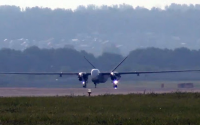Russia produced about 8 new SU-57s in 2022. China produced ~70 new J-20s in 2022.
Su-57 barely coming out of weopon testing and reliability phase so i will not count it yet. Su-57 has that unique engine sound so it is not just electronics, weopon testing but engines are different.
Russia produced upto 550 Su-30 TVC Indian version of Planes and that just one factory. so scaling up a production is not problem.
what has changed is factories are increasingly multifunctional, products are complex, future proof. Factory producing Su-57 also produce SSJ. factory produce Su-30SM also produce MS-21 not to mention producing parts in same city that can used in another factory product. this helps in maintaining security, redundancies and air defense.
you can see this IL-96 built around Soviet electronics of 1980s is taking off in basically zero visibility in a city with dense traffic. similar is SSJ operations to Middleast. dealing heat and range requirements when you may need to burn alot of fuel on tarmac and on takeoff in large complex transit airports. this called future proofing of a product to all conditions.
Than there is Civil Aviation where production will be need to increase. behind every product IL-96 / Tu-214/Mi-26T2 whether built 2 per year or 20 per year there will thousands of skilled people that maintain the skill set. this is the cost of maintaining independent aviation industry.

